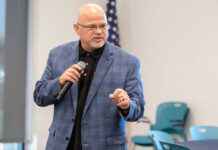
inmaricopa.com runs, on a regular basis, opinion pieces submitted by community members. The following article is the opinion of the author, and does not necessarily reflect the views of inmaricopa.com.
With the new school year fast approaching Legacy Traditional School knows that parents are trying to make an informed decision about their children’s education. We are excited for all we have to offer to the families of this community. We have fantastic teachers and staff, and we are all excited to build upon our Highly Performing ranking and soar even higher. We know that you have choices in your child’s schooling and we would like to help you understand our vision and mission, so that you can make the best choice for your family. Here are answers to some of the most frequently asked questions from the last few months. Feel free to forward these to your friends and neighbors who are also in need of additional information.
With your structured curriculum, do your students have time for fun in the day? We hear feedback from parents almost daily that their children enjoy school here more than they have anywhere else. This is because they are constantly engaged, and the curriculum moves so quickly there is no time to be bored. If someone tells you that they focus on “fun,” just ask them, what are you cutting out to have that “fun.” We try to incorporate enjoyable activities into every lesson. We want to help the students enjoy learning, rather than suggest that learning is not fun, by stopping to do “fun” things. At Legacy we teach our students that learning is fun.
What about schools that say “we teach the child not the curriculum?” What does that mean to you, and what should that mean to me? Typically, when someone says they teach the child, in theory, they are testing each child, and then teaching each child at their own individualized level and pace. While this may sound good in theory, in practice it is near impossible to teach 28 students each their own thing. What happens in practice is that you teach to the low end of the class, so that you make sure that you are meeting the basic requirements of the lowest end of the class. When people say that we at LTS “teach the curriculum,” what that really means is that we teach the curriculum at the speed and pace in which it was intended. With this increased speed and pace, occasionally a student may struggle to grasp concepts at the same pace as their peers. Rather than lower our standards for the whole class, we offer tutoring and other assistance to bring these students up to the higher level and help them regain the pace of the class. Here is a little scenario of what happens in practice, between the two philosophies.
There are two students, student H (high), and student L (low). Total knowledge gained is graded on a 1 – 10 scale for the year. H starts out at a 6, L starts out at a 2. There are 28 kids in the class.
Teach the child:
· The teacher tests all students and sees a standard bell curve of their abilities. Most are between 4 and 6, with a quarter higher and a quarter lower.
· The teacher feels bad for the students in the lower quadrant and wants to ensure that they feel successful, so all lessons and activities are geared toward that lower group.
· The pace is slow, and so the lower group is able to move at their pace and feels satisfied in the slow, steady progress that they are making. L feels good about school.
· The students in the middle and high end are bored. Student H is bored. Each lesson he finishes the material in the first few minutes, and then tunes out for the rest of the lesson. He becomes a behavior problem because he is bored and looking for something to do.
· By the end of the year, L has moved from 2 – 4, H has moved from 6 – 8. They have both learned and grown. H mostly on his own and L with the rest of the class.
Teach the curriculum:
· The teacher begins teaching the curriculum at the accelerated pace that is intended
· All the students do well initially, though after a few weeks, the teacher notices a few students who are struggling a bit, including L. The teacher talks to the few students who are struggling a bit, including L. The teacher talks to their parents and invites them into early morning tutoring. After a few weeks they are more comfortable with the curriculum and no longer need the tutoring. They are always challenged throughout the year and are excited as they master new concepts and ideas.
· Student H is challenged throughout the year. He shines as he quickly masters new material. The teacher recognizes how quickly he is moving and gives him additional materials to continue challenging him.
· By the end of the year, L has moved from 2 – 8, H has moved from 6 – 10. They have both been able to achieve dramatic results because the expectations placed upon them were high, and they were given the tools to succeed. L struggled in the beginning and had to work harder, but overcame his weaknesses and was able to increase dramatically. H was consistently challenged and able to grow and succeed without limitations.
We teach to the high end of the class. Rather than slowing the curriculum for a few, we give them additional help and tools to succeed. Teachers are still responsible for monitoring the entire class and adapting to the needs that she sees. One example of this is that several times last year the first grade classes noticed a problem in math or in spelling that was class wide, so they stopped the forward progression to spend extra time reviewing the items of particular need before moving forward again.
Is there going to be any ranking of kids within a grade? And why or why not? Students will not be ranked and placed into classes by that rank. What that tends to do is reinforce your current status and not allow for progression between strata. The question I ask when people talk about ranking and placing kids according to that rank is, “Will my student be changing classes during the year if they improve and now qualify for the higher ranked class?” By keeping a heterogeneous mix of students in each class and then expecting that all the kids perform at the high end, and helping them to do so, everyone is brought up and moves along more quickly. In a segregated class the teachers and students know which class is which. The lower class will go considerably slower than the higher classes, and as the years progress, the difference between them will become more and more pronounced.
We feel strongly that students should not be labeled as high or low, a thinly veiled code for advanced or slow. Students may have obtained different levels of academic achievement by a given test date, but we feel that all of them need to be given the chance to rise to the highest levels. We expect the highest levels of achievement from all our students, and consistently see them reach and surpass our expectations. Ranking often inhibits this growth and stymies personal student progress.
What do you do to help students who are higher or lower than their class? All of our teachers have been trained in a process called Depth and Complexity. What that means is that as a teacher identifies a student who is grasping concepts more quickly, and ready to move at a more rapid pace; they use Depth and Complexity to weave more advanced concepts into lessons to stimulate and encourage those who are grasping the concept. They also create assignments that utilize the same concepts of the day’s lesson, but at a level that challenges the student.
For those students who are struggling, we require that all of our teachers offer before/after school tutoring. As the teacher notices that your child is struggling in a particular area, they will contact you and invite your child to attend additional tutoring. Usually it is for a ½ hour, 1 – 2 times a week. Typically, after 4 – 8 weeks the student has mastered the area of concern, gotten back in line with their class, and no longer needs the additional tutoring.
Why do you have homework every day? Homework is a vital part of our curricular program. It is a necessary component to reinforce the material that the student learned and reviewed that day. Homework is not a time for learning new material but rather for reviewing the material already learned, and helping to move that concept from short term, to long term memory. We only give homework four days a week, Monday – Thursday, with a set maximum time, 10 – 15 minutes for kindergartners, and increasing yearly from there. This year we will be instituting a new practice to ensure that the homework is completable by the average student in the time allotted. Periodically throughout the year, the teacher will take the final portion of class to allow the students to complete the homework in class. This will allow us to track how long homework is taking and help our teachers to adjust the homework loads accordingly.
The daily homework slip is signed by a parent each night. This helps to ensure that parents are reviewing their child’s homework with them, and checking to make sure that they understand it. It helps the parent gauge the progress of their student and be more aware of what is being taught in class. The homework slip also contains a comment sheet for parents to write notes to the teachers, encouraging communication and allowing the parent to give immediate feedback to the teacher.
Why do your students sit in straight rows, or walk in straight lines? With the students facing forward in rows, they are better able to focus on the lesson and the teacher. Rather than
facing another student in a pod, or cluster, they are facing the teacher, minimizing other distractions. Our students walk in straight lines to ensure the teacher’s ability to maintain order and safety for their entire class while they are transitioning from one room to another.
How do you select your teachers? This year we interviewed over 600 teachers in order to fill the approximately 30 openings that we had. Teachers were first screened to ensure that their educational vision and ideals fell in line with that of LTS. They were then invited to come to our campus for a second interview, allowed to observe our classes in action, and then asked to present a 10 – 15 minute lesson to one of our classes. Through these methods we were able to find those teachers who best fitted with the vision of Legacy and whom we felt would do the best job educating your children.
How are your teachers trained? Are they certified? All of our teachers are certified, but we have set a higher standard for ourselves, so, in addition to the standard certification, all of our teachers participate in an intense two-week training course before the start of school each year. They receive 45 hours of instruction in the Spalding Method from a Spalding Certified instructor. They also receive training in the Saxon Math program, Direct Instruction, Depth and Complexity, LTS Vision and Mission, Positive Discipline, Bully Prevention, Special Education, Differentiated Instruction, and much more. Throughout the year they also receive additional professional education, and we have mentoring program in place to help our newer teachers continue to grow and improve. This intense training and continuing education was a major factor in our ability to receive a Highly Performing ranking, in only our second year.
Is your school a place I can count on to educate my little ones through high school? We plan to expand to our grade level offering through 12th grade. Obviously it will depend on demand. We went from K – 6, to K – 8, to K – 9. If everything goes smoothly, and we have sufficient 9th graders, then we will add 10th grade and so on. It isn’t really a matter of if, simply when.
Are your buildings going to be done on time? The contractor has assured us that the buildings will be completed in the next week and a half, and will be turned over to us so that we can begin moving in and preparing for the start of school. The site work portion will go down to the wire, but we are confident that it will also be completed in time to allow school to start on August 25.
It has been rumored that Legacy has not paid some of its debts relating to its previous site; is there any truth to this? No. Legacy has always paid all of its debts and is current with all of our vendors. In our previous site we were only a tenant and only responsible for monthly lease payments, which we always made. The developers of that property are the ones who entered into contracts on that site and are responsible for their payment.
Legacy Traditional School is located at 17760 N. Regent Drive; phone: 520-423-9999 or by email at [email protected].
Photo by Michael K. Rich
Have an opinion you’d like to share with Maricopa? Please email it and any applicable photos to [email protected] for consideration.












![GAME OVER: The city government tried to get into gaming. It failed Maricopa Esports [Victor Moreno]](https://www.inmaricopa.com/wp-content/uploads/2024/05/263342f5-13e7-4668-838c-f574392086fb-100x70.jpg)


![Carl’s Jr plans to “open soon” An exterior view of the new Carl's Jr. restaurant along John Wayne Parkway on May 7, 2024. [Elias Weiss]](https://www.inmaricopa.com/wp-content/uploads/2024/05/E1C66482-CB4C-4FD0-BA30-35CECE93F4BE-100x70.jpeg)